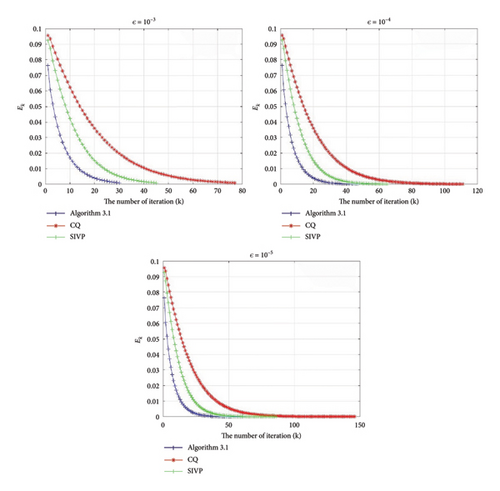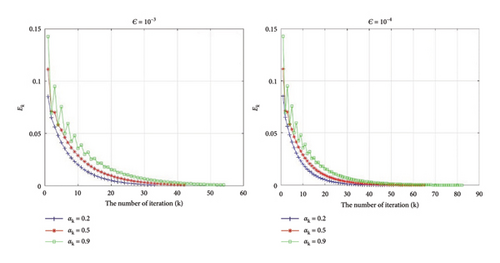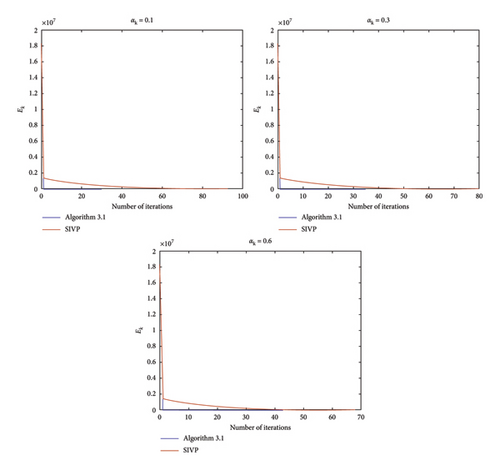Inertial CQ Algorithm With Correction Terms for Split Feasibility Problems With Multiple Output Sets
Abstract
We propose a new CQ algorithm which combines the inertial technique and correction terms for solving the split feasibility problem with multiple output sets in Hilbert spaces. Under suitable conditions, we prove the weak convergence. Moreover, we demonstrate the linear convergence when the split feasibility problem with multiple output sets satisfies some bounded linear regularity property. Finally, numerical experiments are conducted to demonstrate superiority of our method over related inertial CQ method and classical CQ method for the split feasibility problem with multiple output sets.
1. Introduction
- i.
Our algorithm employs correction terms and self-adaptive step-size λk in each iterive step to improve the convergence
- ii.
Under some mild assumptions, we analyze the weak and linear convergence of the generated sequence
The rest of the paper is organized as follows: In Section 2, we present fundamental concepts and lemmas. Section 3 proposes an inertial CQ algorithm with correction terms for solving the SFPwMOS problem and shows its weak and linear convergence. In Section 4, we test the efficacy of the algorithm by two numerical experiments. Finally, some conclusions are given in Section 5.
2. Preliminaries
We recall some definitions and basic results that will be used in Section 3.
- a.
Nonexpansive if ‖Tx − Ty‖≤‖x − y‖, for all x, y ∈ H;
- b.
Firmly nonexpansive if for all x, y ∈ H.
Equivalently, ‖Tx − Ty‖2 ≤ 〈x − y, Tx − Ty〉 for all x, y ∈ H.
From [26], T is firmly nonexpansive if and only if I − T is firmly nonexpansive.
Lemma 1. The following statements hold in:
- i.
for all x, y ∈ H;
- ii.
for all x, y ∈ H;
- iii.
.
3. Algorithm and Convergence
This section first introduces our inertial CQ algorithm with correction terms, then discusses its weak convergence and linear convergence rate.
Algorithm 1. Inertial CQ algorithm with correction terms.
Remark 1. Obviously, implies that . To ensure that λk is well-defined, we assume that ∇g(Wk) ≠ 0 in our convergence analysis.
3.1. Weak Convergence Analysis
To demonstrate the weak convergence and linear convergence rate, we need the following assumption and lemma.
Assumption 1. Throughout our convergence analysis, we assume that
- a.
0 < lim inf ρk≤ limsup ρk < 4;
- b.
The solutions set S is nonempty.
Proof 1. For the rest of the convergence analysis of this paper, we define
Hence, βk ≥ 0 and βk+1 ≤ βk since αk ∈ [0, 1) and δ ∈ [0, 1). Furthermore, we have from (34) that limk⟶∞ βk exists and {βk} is bounded. So, {yk} is bounded from (33).
Theorem 1. The sequence {xk} generated by Algorithm 1 converges weakly to a point in when Assumption 1 is satisfied.
Proof 2. Since {xk} is bounded from Lemma 2, we have that {xk} has at least one accumulation point v ∈ H. Suppose such that . We show that . Since C is a closed and convex subset of H, then C is weakly closed. Now, since and , it then follows that v ∈ C. To show that , we consider these two cases.
Hence, Aiv ∈ Qi, i⟶∞.
Remark 2. We obtain boundedness and convergence of {xk} generated by Algorithm 1 using Assumption 1 without using the on-line rule: Choose αk such that and
3.2. Linear Convergence
In this subsection, we give the linear convergence rate of the sequences generated by Algorithm 1 under the following bounded linear regularity property of SFPwMOS:
Theorem 2. Let . Assuming that the SFPwMOS problem satisfies the bounded linear regularity property. {xk} generated by Algorithm 1 converges to a solution R-linearly when Assumption 1, αk = 0, δ = 0, ∀k ≥ 0, are fulfilled.
Proof 3. From (15), we have
By Lemma 2, we have that wk is bounded. Therefore, ∃r > 0 such that . Using the condition that SFPwMOS fulfills the bounded linear regularity property, it follows that ∃γr > 0 such that
We then obtain from (54) that
We then obtain from (26) that ∀k ≥ k2,
Thus, ∀k ≥ k2,
Since 0 < lim inf ρk ≤ limsup ρk < 4, we obtain
Hence,
Consequently,
So, ∃k3 ≥ k2 such that
Then, it is easy to see that {xk} converges linearly to z.
4. Numerical Experiment
In this section, we examine two numerical experiments to compare the effects of Algorithm 1, classic CQ in [2] and SIVP in [23]. All the codes are written in MATLAB and are performed with RAM 8 GB and Intel(R) Core (TM) i7-8265U CPU @ 1.60 GHz. We consider the following problems:
Example 1. Find a point x∗ such that
In the experiments, we use Ek ≤ ϵ as the stopping criteria, where Ek≔TOLk,
Firstly, for Algorithm 1 we take αk = 0.1, ρk = 3.0, δ = 0.1, w−1 = (0.2, 0.3, 0.5), w−2 = (0.3, 0.6, 0.9); in [23] for CQ, we take λk = 1, and in [23] for SIVP, we take λk = 1, tk = 0, ρk = 3.0 and αk = 0.1. The ϵ = 10−3, 10−4, 10−5, respectively. Then, we chose initial points x−1 = (0, 0.1, 0), x0 = (0, 0.1, 0) for Algorithm 1, SIVP and x0 = (0, 0.1, 0) for CQ to compare the experimental effects of the three groups. The behavior values of the function Ek with different ε are listed in Table 1, where “Iter.” and “Cpu” denote the number of iterations and cpu time in seconds.
We also plot Ek versus the number of iterative in Figure 1.
Obviously, from Table 1 and Figure 1, Algorithm 1 takes much less iterations and computing time than SIVP and CQ algorithm.
Secondly, select ρk = 3, δ = 0.1, w−1 = (0.2, 0.3, 0.5), w−2 = (0.3, 0.6, 0.9) for the same initial points x−1 = (0, 0.1, 0), x0 = (0, 0.1, 0), and we test the results for different αk and ε for Algorithm 1.
The behavior of the function Ek in Table 2 is described in Figure 2.
From Table 2 and Figure 2, we can see that as ε increases, the iteration steps decrease but when αk increases, the iteration steps still increase.
| ε | 10−3 | 10−4 | 10−5 | |||
|---|---|---|---|---|---|---|
| Algorithm 1 | Inter. = 30 | Cpu = 0.01 | Inter. = 47 | Cpu = 0.031 | Inter. = 63 | Cpu = 0.055 |
| TOLk = 9.4237E − 04 | TOLk = 8.8209E − 05 | TOLk = 9.3113E − 06 | ||||
| SIVP | Inter. = 45 | Cpu = 0.012 | Inter. = 65 | Cpu = 0.042 | Inter. = 85 | Cpu = 0.072 |
| TOLk = 9.5199E − 04 | TOLk = 9.31750E − 05 | TOLk = 9.3560E − 06 | ||||
| CQ | Inter. = 77 | Cpu = 0.16 | Inter. = 111 | Cpu = 0.052 | Inter. = 146 | Cpu = 0.096 |
| TOLk = 9.6469E − 04 | TOLk = 9.9749E − 05 | TOLk = 9.8560E − 06 | ||||

| ε | αk = 0.2 | αk = 0.5 | αk = 0.9 |
|---|---|---|---|
| 10−3 | Iter. = 33 | Iter. = 42 | Iter. = 54 |
| TOL = 9.7664E − 04 | TOL = 9.7212E − 04 | TOL = 9.3819E − 04 | |
| 10−4 | Iter. = 51 | Iter. = 65 | Iter. = 82 |
| TOL = 9.6424E − 05 | TOL = 9.1123E − 05 | TOL = 9.5076E − 05 | |

Example 2. Consider the following monotone inclusion problem [32]:
The projection onto the set C can be computed as
The projection onto the set Q can be computed as
Let
Figure 3 plots the trend of Ek with the iteration for αk = 0.1, 0.3, 0.6, with initial points (x0, x−1) = (t3, t3) for Algorithm 1 and SIVP, respectively.
Table 3 and Figure 3 also show that our algorithm performs better than SIVP.
Based on the above two numerical experiments, we can see that the application of the inertial technique and correction terms can improve the performance of the algorithm.
| Iter. for Algorithm 1 | Iter. for SIVP | ||||||||||
|---|---|---|---|---|---|---|---|---|---|---|---|
| x0 | x−1 | w−1 | w−2 | αk = 0.1 | αk = 0.3 | αk = 0.6 | x0 | x−1 | αk = 0.1 | αk = 0.3 | αk = 0.6 |
| t2 | t | t2/5 | t2/5 | 16 | 18 | 21 | t2 | t | 44 | 31 | 25 |
| t2 | t2 | t2/5 | t2/5 | 18 | 19 | 22 | t2 | t2 | 53 | 47 | 43 |
| t3 | t2 | t2/5 | t2/5 | 29 | 30 | 35 | t3 | t2 | 86 | 72 | 67 |

5. Conclusions
In this paper, we propose an inertial CQ algorithm with correction terms for solving SFPwMOS. Under some suitable conditions, we show the weak convergence and linear convergence results by the bounded linear regularity property. Two numerical experiments show that our algorithm performs better than other algorithms.
Conflicts of Interest
The authors declare no conflicts of interest.
Author Contributions
Yang Liu, Yazheng Dang, and Kang Liu wrote the main manuscript text. All authors carried out all the experiments and reviewed the manuscript.
Funding
This work was supported by the National Key Research and Development Program of China (2023YFC3306100, 2023YFC3306105, 2023YFC3306103), Major Projects of the National Social Science Foundation (20&ZD199), Shanghai Philosophy and Social Science Planning Project (2023EFX011), National Natural Science Foundation of China under grants 72071130 and 71901145, and Humanities and Social Sciences Research Project of the Ministry of Education under grant 20YJC820030.
Open Research
Data Availability Statement
The data used to support the findings of this study are included within the article.




